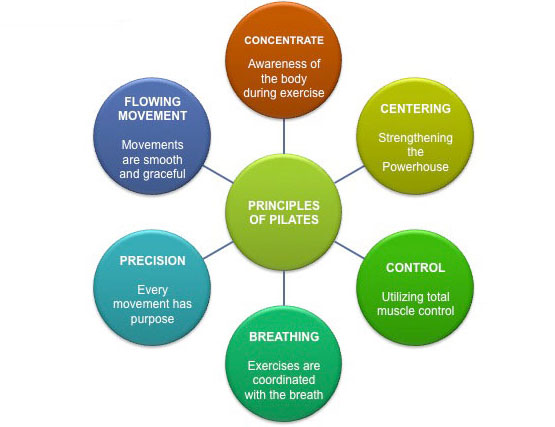Pilates Principles

CENTERING
In Pilates, the starting point and source of all movement is the center of the body, or the Powerhouse , which is located in the pelvis, just bellow the navel. Anatomically, our center connects several large muscle groups and refers to the musculature located deep within the abdominal area. From your center you support your spine and major organs. You strengthen the back and improve alignment and posture. With a properly developed center you are less vulnerable to fatigue and lower-back pain.
Visualize your center as a sphere. As you contract the muscles in this area, imagine the sphere shrinking in size—a three-dimensional movement. During Pilates exercises you and your participants want to maintain this contraction without holding your breath.
Centering is helpful in our lives because it teaches us to utilize our core as the impetus for our movement. This helps us to become stronger and aids in correct alignment and form in all we do, such as waiting in line at the store, sitting at our desks all day. With a strong center and proper posture and spinal alignment, we are less likely to injure ourselves.
CONCENTRATION
Pilates' method is based on mindfulness.
The mind-body connection is at the very core of Pilates, and the key to coordinating mind and body is concentration. In this discipline, the focus is on careful, precise and slow foundation work. The Pilates principle of Concentration is about bringing full attention and commitment to each exercise in an effort to gain the most benefit from the workout. During each movement, stay aware, not only of the moving body part, but also of what the rest of the body is doing
Learning to be mindful and focused on the present can benefit us in countless ways. By concentrating only on the task at hand, our concentration improves and we perform better.
CONTROL
In Pilates, you perform every single exercise with complete muscular control. Each muscle and body part works together to carry out the exercises.
In Pilates, control is essential to the quality of every movement. Overexertion of the muscles in not a principle of Pilates. The underlying assumption is that exercise motions and movements performed without control can lead to injury, but exercises performed with control produce positive results.
The principle of Control extends beyond our Pilates mats and Equipment classes. You learn to control your bodies and move with steadiness all the time, which makes you less likely to make jerky or potentially injurious movements.
PRECISION
According to Pilates' precision principle, executing one exercise with deliberate exactitude is more important than completing more repetitions with sloppier form.
Every movement in Pilates has a purpose. It is important to be cognizant of correct body placement and to understand how each part of our body functions in conjunction with each other. Movement precision builds on concentration. Precision is achieved by clearly moving, directing and placing the body and its parts. Realize that every movement has a purpose and every cue or instruction is important to the success of the movement.
BREATH
Deep, controlled, diaphragmatic breathing activates blood circulation and awakens cells and muscles. Pilates recommended visualizing the lungs as bellows as you bring air in to the fullest and release it in the same manner. He wrote that breathing is the most integral part of exercise, and even if one follows no other recommendation, learning to breathe correctly is the most important thing.
In Pilates exercises, movement is propelled by breath. Joseph Pilates, the founder of Pilates, often advised people to use their lungs to powerfully pump air completely in and out of the body. Conscious breathing and specific breathing patterns assist movement by focusing the attention and direction of the body and by delivering oxygen to the muscles being used. Full breathing also assists in removing non beneficial chemicals that may be stored in the muscles
Pilates, like yoga, calls for complete, thorough and purposeful inhalation and exhalation. But in Pilates, unlike in yoga, inhalation is through the nose and exhalation through the mouth.
FLOW
Pilates exercises are completed in a smooth, steady and continuous manner, with each movement flowing gracefully into the other. Dynamic fluid movement makes Pilates different from other exercise techniques. Smoothness and evenly flowing movement go hand in hand, assisting the connections (or transitions) between movements.